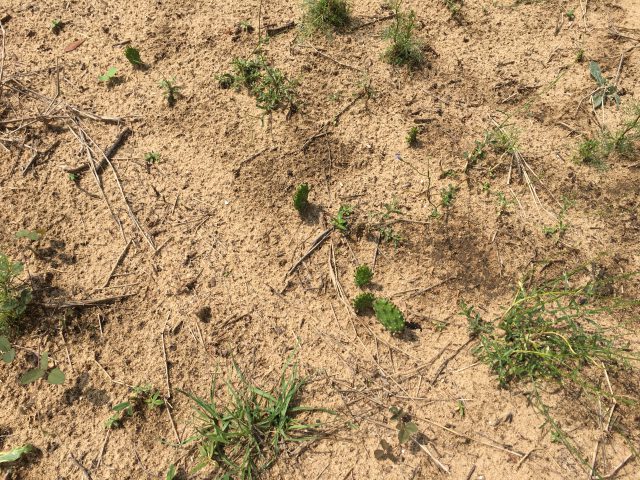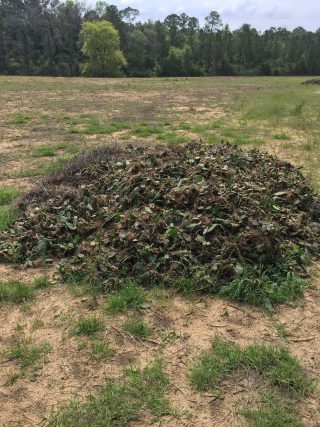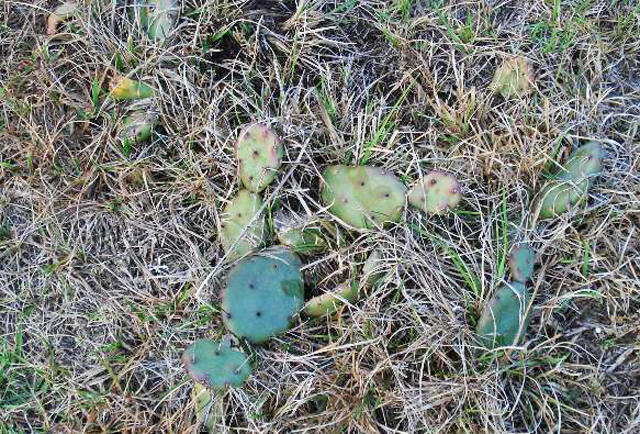
Prickly Pear is one of those tenacious, tough to handle weeds that you hate to find growing in your pastures and hay fields. It can be very difficult to control and eradicate. This weed typically spreads and reproduces via fragmentation of original plants, such as occurs in the cultivation and planting of new pastures. Each individual piece can root and produce a new colony of plants. Mowing is not a good option for controlling this weed, as it actually encourages rapid increase of the plant population. The barbed quills are a hazard to grazing livestock and can be a source of infections in addition to decreasing animal utilization of the forage, as livestock will avoid infested areas.

Hand removal (Photo 2) is one possible option in small fields, but is very labor intensive and costly. This operation also can cause increased fragmentation increasing populations of the weed. Repeated trips across the field will be required but may be the only practical option if the crop is a legume such as perennial peanut.
In grass pastures we do have some options for chemical control. Dr. Jay Ferrell and Dr. Brent Sellers, UF/IFAS weed specialists, recommend the following plans of attack.
Spot Applications
For spot spray situations, Vista XRT can be applied in water at 0.5 oz. per 1 gal, while TrumpCard can be applied at 2 oz per 1 gal of water. Spray the pads to achieve good coverage but not to the point of runoff. Over-application can result in grass damage, but will not likely be as severe as with the traditional triclopyr and diesel program.
Broadcast Applications
Recent experiments conducted at UF/IFAS have found that broadcast applications of Vista XRT herbicide at a rate of 22 oz/A, applied in either spring or fall, can effectively control prickly pear. Additionally, a split application of Vista XRT at 11 oz/A in the spring followed by another 11 oz/A in the fall was also effective. Likewise, TrumpCard can be applied at 48 oz/A followed by an additional 48oz the following season. Failure to make two applications of TrumpCard with a total of 96 oz over two growing seasons will likely result in marginal control.

It is important to note that even though Vista XRT and TrumpCard are effective on prickly pear, control is generally very slow. After the application, the quills will turn gray and dry out while the pads will swell and turn a green/gray color (Photo 3). It is common for treated plants to persist this way for 6–8 months after the application. But don’t get discouraged when the plants do not disappear quickly. This does not mean the herbicide is not working. Prickly pear grows fairly slowly so it takes longer for the herbicides to take full affect.
For newly established pastures, the Trump Card product label recommends allowing establishment prior to herbicide application. It is generally recommended that bahiagrass should not be treated with herbicides until the seedlings are at least 6″ tall after planting. Both herbicides have a seven day grazing restriction following application.
Trump Card Label:
Do not apply to newly seeded areas until grass is well established. Reseeding is not recommended for at least 30 days following application. Addition of a surfactant may increase the risk of injury to newly seeded grasses.
For more information, use the following UF/IFAS Extension fact sheet link:
Prickly Pear Cactus Control in Pastures
 1
1
